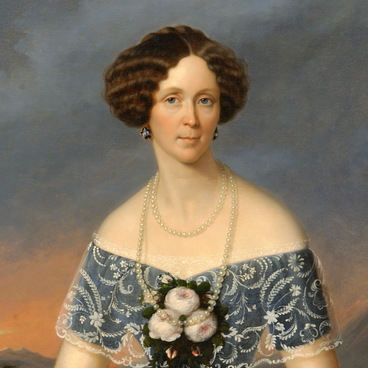A Shepherd Boy Standing Before the Parthenon is one of the rare paintings in the collection of the Stavropol Krai Museum of Fine Arts. This is the work of art by Elisabeth Jerichau-Baumann, a Danish painter of German origin.
Elisabeth was born in Poland but her father sent her to live with their relatives in Germany due to the revolution of 1829. At the age of 19 Elisabeth decided to study art. Since no women were admitted to art schools, she began taking private painting lessons in Dusseldorf. Her early genre paintings were drawn from Slovak life. She was a master of color and light-and-shade but failed to pay much attention to her drawings. This was the only feature that gave away the lack of professional education. After moving to Rome in 1845 the subject of her paintings became the scenes of everyday Italian life. In 1849 Elisabeth together with her husband and children moved to Copenhagen as her husband, Danish sculptor Jens Jerichau, received an invitation to become a professor of the Danish Royal Academy of Fine Arts.
Elisabeth received a cold welcome in Denmark but still had lots of orders from Russia, Greece and the UK thanks to recommendations of the royal family. The painter enjoyed a great popularity abroad, her exhibitions were held in France, Sweden, Germany and England. In the late 1860s Elisabeth Jerichau and her son made a grand tour across the Eastern Mediterranean and Middle East. She managed to gain access to the harem in the Ottoman Empire and was able to paint several scenes of harem life from her personal observations as opposed to imagination.
A Shepherd Boy Standing Before the Parthenon was painted by Elisabeth during her voyage. Her artworks of this period were decorative, full of atmospheric details and sensual. Their sensuality was the reason why the Danish society ignored the painter and the museums kept her works in the storage vaults.
The Stavropol museum has the picture of a Greek shepherd against the ruins of Parthenon, the most famous monument of ancient Greece. Elisabeth painted a young man who holds a baby lamb in his arms, leaning against the ancient stone. He wears a loose chiton supported by the belt around his waist. He has a sheepskin over his right shoulder and his hair is gathered up by a piece of colored cloth, with hair locks hanging down around the face.
Before joining the collection of the Russian Imperial House of the Romanovs, A Shepherd Boy Standing Before the Parthenon was successfully displayed at the World’s Fair in Vienna in 1873 as well as exhibitions held by the Prussian Royal Academy of Arts in 1874 and 1879.
Elisabeth was born in Poland but her father sent her to live with their relatives in Germany due to the revolution of 1829. At the age of 19 Elisabeth decided to study art. Since no women were admitted to art schools, she began taking private painting lessons in Dusseldorf. Her early genre paintings were drawn from Slovak life. She was a master of color and light-and-shade but failed to pay much attention to her drawings. This was the only feature that gave away the lack of professional education. After moving to Rome in 1845 the subject of her paintings became the scenes of everyday Italian life. In 1849 Elisabeth together with her husband and children moved to Copenhagen as her husband, Danish sculptor Jens Jerichau, received an invitation to become a professor of the Danish Royal Academy of Fine Arts.
Elisabeth received a cold welcome in Denmark but still had lots of orders from Russia, Greece and the UK thanks to recommendations of the royal family. The painter enjoyed a great popularity abroad, her exhibitions were held in France, Sweden, Germany and England. In the late 1860s Elisabeth Jerichau and her son made a grand tour across the Eastern Mediterranean and Middle East. She managed to gain access to the harem in the Ottoman Empire and was able to paint several scenes of harem life from her personal observations as opposed to imagination.
A Shepherd Boy Standing Before the Parthenon was painted by Elisabeth during her voyage. Her artworks of this period were decorative, full of atmospheric details and sensual. Their sensuality was the reason why the Danish society ignored the painter and the museums kept her works in the storage vaults.
The Stavropol museum has the picture of a Greek shepherd against the ruins of Parthenon, the most famous monument of ancient Greece. Elisabeth painted a young man who holds a baby lamb in his arms, leaning against the ancient stone. He wears a loose chiton supported by the belt around his waist. He has a sheepskin over his right shoulder and his hair is gathered up by a piece of colored cloth, with hair locks hanging down around the face.
Before joining the collection of the Russian Imperial House of the Romanovs, A Shepherd Boy Standing Before the Parthenon was successfully displayed at the World’s Fair in Vienna in 1873 as well as exhibitions held by the Prussian Royal Academy of Arts in 1874 and 1879.



